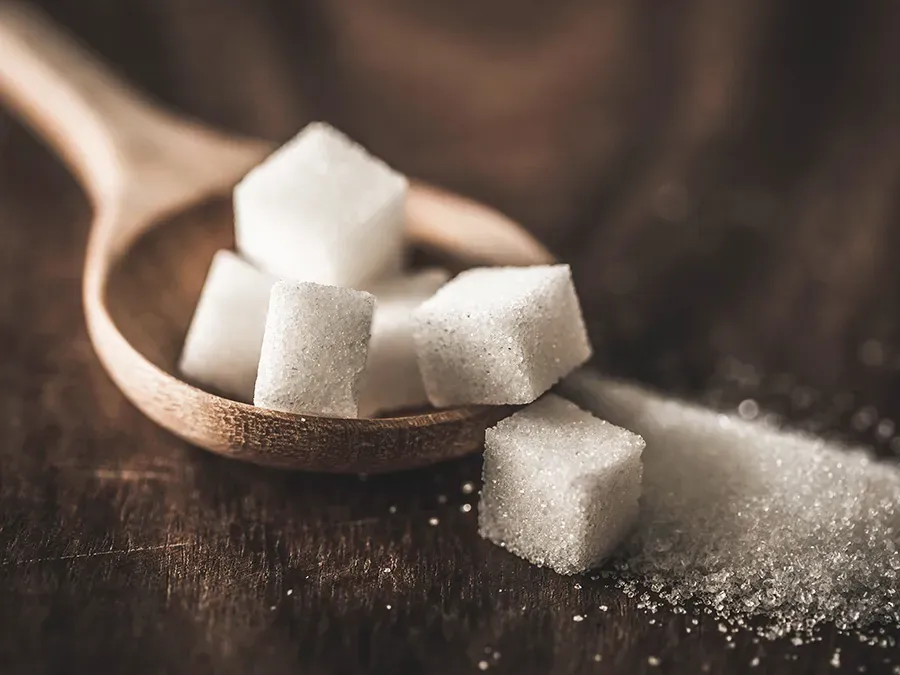Does Sugar Really Turn into Fat?

A Deep Dive into the Science and Practical Ways to Manage Sugar Intake
Sugar, the sweet culprit that graces our taste buds, has long been under scrutiny for its potential health impacts. But does sugar really turn into fat in our bodies?
The Science Behind Sugar Metabolism: A Closer Look
Glucose: The Body's Primary Energy Source
When we consume foods containing carbohydrates, such as sugars, they are broken down into simpler forms, primarily glucose.
Glucose is a simple sugar that our bloodstream readily absorbs. It's the primary fuel for our cells, especially the brain, which relies heavily on glucose for its energy needs.
Insulin's Role in Glucose Metabolism
Once glucose enters the bloodstream, the pancreas releases a hormone called insulin. Insulin acts as a key, allowing glucose to enter cells where it can be used for energy. Without insulin, glucose would remain in the bloodstream, leading to high blood sugar levels.
Storing Excess Glucose
Our bodies are efficient machines that don't like to waste resources. When there's an abundance of glucose in the bloodstream—often after a carbohydrate-rich meal—the body seeks to store it for later use.
The first storage spot is in the liver and muscles in the form of glycogen. Think of glycogen as a compact, branched structure of glucose units, a bit like a tree made of glucose.
The Liver's Central Role in Glucose Overload
The liver is a multitasking organ with various functions, one of which is managing our energy stores.
When the liver and muscles have reached their glycogen storage capacity, the liver takes any additional glucose and begins the process of turning it into fat through a process called de novo lipogenesis.
During de novo lipogenesis, the liver converts excess glucose into fatty acids. These fatty acids are then packaged with glycerol to form triglycerides. Triglycerides are the primary form of fat storage in the body.
From the Liver to Fat Cells
Once these triglycerides are formed, they are released into the bloodstream and transported to fat cells (adipocytes) scattered throughout the body.
Here, they are stored as fat, ready to be used as an energy source when glucose levels drop, such as during fasting or prolonged exercise.
The Implications of Chronic Overconsumption
While this storage mechanism is a testament to our body's adaptability and survival instincts, chronic overconsumption of sugars can lead to an overworked liver, consistently high insulin levels, and eventually, the development of fat deposits.
Over time, this can contribute to conditions like non-alcoholic fatty liver disease and insulin resistance, precursors to more severe metabolic disorders.
The Link Between Sugar and Weight Gain
Caloric Surplus: The Fundamental Principle of Weight Gain
At its core, weight gain is a simple mathematical equation: when you consume more calories than your body expends, you gain weight.
This principle is known as a caloric surplus.
Every food and drink we consume provides calories, which are units of energy. Our bodies need this energy to function, from powering our cells to supporting physical activity.
Sugar: A Stealthy Contributor to Caloric Surplus

Sugar is particularly adept at contributing to a caloric surplus for several reasons:
- High Caloric Density: Gram for gram, sugar is calorie-dense. A single teaspoon of sugar contains about 16 calories. While this might not sound like much, it quickly adds up, especially when you consider how liberally sugar is added to many processed foods and beverages.
- Rapid Absorption: Sugars, especially simple sugars like glucose and fructose, are rapidly absorbed into the bloodstream. This quick absorption can lead to spikes in blood sugar levels, followed by a rapid drop, which can trigger feelings of hunger and a desire to eat more.
- Limited Satiety: Unlike proteins and fats, which can make you feel full and satisfied, sugars don't have the same satiating effect. This means you might consume a high-calorie sugary snack and still feel hungry shortly after.
The Nutritional Void of High-Sugar Foods
Many foods and drinks high in added sugars are nutritionally void, meaning they offer little to no essential vitamins, minerals, fiber, or other beneficial compounds. This presents a double-edged sword:
- Lack of Nutrient Density: When we consume foods that lack essential nutrients, our bodies might not feel truly "nourished," even if we've consumed a lot of calories. This can lead to a phenomenon where we're "full but not satisfied," prompting further eating in search of those missing nutrients.
- Displacement of Nutrient-Rich Foods: High sugar consumption can also displace healthier, nutrient-rich foods from our diet. For instance, if you fill up on sugary snacks, you're less likely to consume fruits, vegetables, lean proteins, and whole grains, all of which provide essential nutrients and promote feelings of fullness.
The Vicious Cycle of Overconsumption
The combination of sugar's caloric density, its lack of satiety, and the nutritional emptiness of many high-sugar foods can create a feedback loop.
You consume sugar, you don't feel full, you crave more food (often more sugar), and the cycle continues.
Over time, this pattern can lead to consistent overeating, a sustained caloric surplus, and, ultimately, weight gain.
In conclusion, while sugar in moderation can be part of a balanced diet, its overconsumption, especially in the form of added sugars in processed foods, can stealthily contribute to weight gain. Being mindful of sugar intake and prioritizing nutrient-dense foods can help break the cycle and support overall health.
Tangible Ways to Manage Sugar Intake
- Read Nutrition Labels: Always check the amount of added sugars in products. You'd be surprised how much sugar can be found in seemingly healthy foods.
- Opt for Natural Sweeteners: Instead of refined sugars, consider using honey, maple syrup, or stevia. While they still contain calories, they often have additional nutrients and are less processed.
- Stay Hydrated: Sometimes, our bodies confuse thirst with hunger. Drinking water can help curb sugar cravings.
- Mindful Eating: Pay attention to what you eat and savor each bite. This can help reduce overconsumption and make you more aware of your sugar intake.
Reflecting on Our Sugar Journey
Understanding the science behind sugar metabolism empowers us to make informed decisions about our diet.
It's not about completely eliminating sugar but finding a balance that aligns with our health goals. As we navigate the sweet waters of sugar consumption, let's remember to be kind to ourselves and enjoy life's sweet moments in moderation.